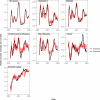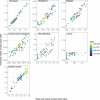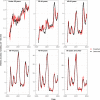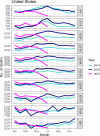Direct and indirect mortality impacts of the COVID-19 pandemic in the United States, March 1, 2020 to January 1, 2022
- PMID: 36811598
- PMCID: PMC9946455
- DOI: 10.7554/eLife.77562
Direct and indirect mortality impacts of the COVID-19 pandemic in the United States, March 1, 2020 to January 1, 2022
Abstract
Excess mortality studies provide crucial information regarding the health burden of pandemics and other large-scale events. Here, we use time series approaches to separate the direct contribution of SARS-CoV-2 infection on mortality from the indirect consequences of the pandemic in the United States. We estimate excess deaths occurring above a seasonal baseline from March 1, 2020 to January 1, 2022, stratified by week, state, age, and underlying mortality condition (including COVID-19 and respiratory diseases; Alzheimer's disease; cancer; cerebrovascular diseases; diabetes; heart diseases; and external causes, which include suicides, opioid overdoses, and accidents). Over the study period, we estimate an excess of 1,065,200 (95% Confidence Interval (CI) 909,800-1,218,000) all-cause deaths, of which 80% are reflected in official COVID-19 statistics. State-specific excess death estimates are highly correlated with SARS-CoV-2 serology, lending support to our approach. Mortality from 7 of the 8 studied conditions rose during the pandemic, with the exception of cancer. To separate the direct mortality consequences of SARS-CoV-2 infection from the indirect effects of the pandemic, we fit generalized additive models (GAM) to age- state- and cause-specific weekly excess mortality, using covariates representing direct (COVID-19 intensity) and indirect pandemic effects (hospital intensive care unit (ICU) occupancy and measures of interventions stringency). We find that 84% (95% CI 65-94%) of all-cause excess mortality can be statistically attributed to the direct impact of SARS-CoV-2 infection. We also estimate a large direct contribution of SARS-CoV-2 infection (≥67%) on mortality from diabetes, Alzheimer's, heart diseases, and in all-cause mortality among individuals over 65 years. In contrast, indirect effects predominate in mortality from external causes and all-cause mortality among individuals under 44 years, with periods of stricter interventions associated with greater rises in mortality. Overall, on a national scale, the largest consequences of the COVID-19 pandemic are attributable to the direct impact of SARS-CoV-2 infections; yet, the secondary impacts dominate among younger age groups and in mortality from external causes. Further research on the drivers of indirect mortality is warranted as more detailed mortality data from this pandemic becomes available.
Keywords: COVID-19 pandemic; age-specific excess mortality; direct and indirect pandemic impacts; epidemiology; global health; human; mortality from opioids, accidents, and homicides; respiratory mortality; time series models.
Conflict of interest statement
WL, SW, DW, DO, LS, BG, CV No competing interests declared
Figures

























References
-
- Banerjee A, Pasea L, Harris S, Gonzalez-Izquierdo A, Torralbo A, Shallcross L, Noursadeghi M, Pillay D, Sebire N, Holmes C, Pagel C, Wong WK, Langenberg C, Williams B, Denaxas S, Hemingway H. Estimating excess 1-year mortality associated with the COVID-19 pandemic according to underlying conditions and age: a population-based cohort study. Lancet. 2020;395:1715–1725. doi: 10.1016/S0140-6736(20)30854-0. - DOI - PMC - PubMed
-
- Bollmann A, Hohenstein S, Meier-Hellmann A, Kuhlen R, Hindricks G. Emergency hospital admissions and interventional treatments for heart failure and cardiac arrhythmias in germany during the covid-19 outbreak: insights from the german-wide helios hospital network. European Heart Journal. Quality of Care & Clinical Outcomes. 2020;6:221–222. doi: 10.1093/ehjqcco/qcaa049. - DOI - PMC - PubMed
-
- Centers for Disease Control and Prevention Weekly Counts of Deaths by State and Select Causes, 2014-2019. 2022a. [October 28, 2022]. https://data.cdc.gov/NCHS/Weekly-Counts-of-Deaths-by-State-and-Select-Ca...
-
- Centers for Disease Control and Prevention Weekly Counts of Deaths by State and Select Causes, 2020-2022. 2022b. [October 28, 2022]. https://data.cdc.gov/NCHS/Weekly-Counts-of-Deaths-by-State-and-Select-Ca...
Publication types
MeSH terms
Grants and funding
LinkOut - more resources
Full Text Sources
Medical
Miscellaneous

